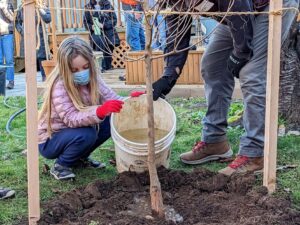Tag: yard trees
Leaflet: Summer Glory
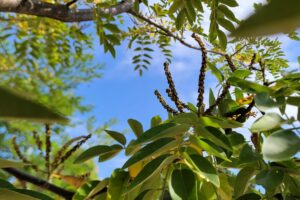
Shop now, plant later
Now is when trees are in their full glory. You can see it, smell it, and feel it whenever you walk around the neighborhood. It’s not a good time to plant trees—we’ll wait until our planting season, October-April—but now is the time to be thinking about what tree you might want to plant. Look for the species on a Friends of Trees tag. Consider how big a tree gets when it’s mature.
“When we call you later this year to see what tree you want, you won’t be able to look around and see what a tree looks like in the middle of summer,” says Neighborhood Trees Senior Specialist Andrew Land. “Summer is an outstanding time to look around.”
Beyond finding a tree whose glory really speaks to you, now is also a great time to think critically about the conditions where a particular tree can succeed. A core aspect of the Friends of Trees ethos is right tree, right place. We want every tree to survive and thrive.
If you see a tree you really like and think, maybe I want one of those, observe the place that it’s in. Consider the conditions: sunlight, moisture, competition, space. Compare those to the conditions in your own yard where you might want a tree.
When we talk about a tree getting full sun, we’re really only talking about the growing season from mid-April through September. The sun exposure in your yard changes considerably from season to season. Now is the time to study how much sun your new tree would get next summer.
“Thinking ahead is how we set up a tree and its steward—you—for success,” Andrew says.
We always invite you to connect with staff about tree selection. And we encourage you to keep an open mind to something new and different. Don’t be afraid of big trees. Consider trees that will be more resilient to climate change. Glory is subjective, and there are so many factors beyond appearance.
“Take the Hardy Rubber Tree, for example,” Andrew says. “It’s nondescript. You wouldn’t necessarily call it pretty. But it’s the best air filter of all the trees.”
Or take the Amur Maackia. It’s not known for its spring flower or its fall color, but it casts a beautiful dappled shade and does really well in the urban environment. When it comes down to it, survivability is the biggest priority.
“Think of all the benefits that a tree provides to people and community,” Andrew says. “Those benefits expand exponentially every year that a tree survives, which is why we want every tree to last as long as possible.”
Leaflet
Restoring the Balance
Today, we’re asking you to put yourself in a tree’s shoes–or roots. Planting day is so exciting for volunteers. We get to hang out with our neighbors, get our hands dirty, and feel good about getting trees in the ground. But planting day is the most stressful day of a tree’s life.
When we plant a tree, we have to cut some of its roots. Container-grown trees need to have their roots cut to prevent them from circling in on themselves, even after they’re put in the ground. Ball and burlap trees are grown in the ground, but they also get their roots cut when they are put into that ball to be moved to their final location.
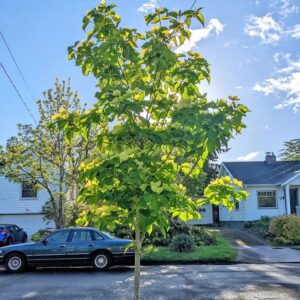
Trees are all about balance. Balance between canopy, where the tree can feed on sunlight and perform photosynthesis, and roots, which pull nutrients from the soil and provide the tree its needed strength and stability. For a newly planted tree, this time of year is all about restoring that balance and getting the roots and the shoots established.
Trees are like icebergs—there’s a lot more going on beneath the surface than we realize. Being able to understand what’s going on underground for our trees helps us better care for them, especially when it comes to watering.
We’ve mentioned watering plenty, but it’s so important that we can’t really talk about it too much. We have had an incredibly wet spring, which is great for the trees! As stewards, we’ve been able to keep our foot off the gas—we haven’t really had to worry about getting out our hose or watering bucket all that much.
But at some point the rain becomes intermittent and shallow enough that it doesn’t reach the tree roots. Watering trees is very different from watering grass, which benefits from frequent and shallow watering. One of the most common watering mistakes is watering your tree like you would your grass, for just a few minutes every day. For trees, we want deep and infrequent. In the summer, a thorough watering once a week is a perfect schedule (see details here).
When you water your tree, imagine what’s going on underground. We want to water the tips of the roots as they spread out. Another common watering mistake is when folks just point their hose at the base of the trunk and water there. You want to simulate a rain storm for your tree, watering all sides, and several feet away from the trunk so that you get the tips of the roots.
Overwatering is rare, but you still want to avoid it. Again, it helps to picture what’s going on beneath the surface. Perfect soil is about 50% air and water pockets. Too much water can flatten those pockets and there’s no air. You’re essentially drowning your roots. Beyond that, too wet soil threatens the stability of the tree. When a tree fails because it’s thrown by the wind, it’s usually because the soil is too wet.
This time of year, we are spectacularly rewarded for our care for our trees. Bud break, flowering, leafing out—it’s a rejuvenating thing to see each spring.
If you’re thinking about getting a new tree for your yard next year, now is a good time to consider which species you might want! What trees are catching your eye? What looks like it might be right at home in your yard. Take note now, and next year, we can get you what you’re looking for!
A lot of trees and tree stories – 16,000+ trees planted so far this season!
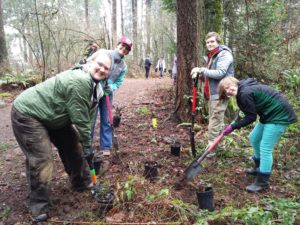
“It was an amazing day, perfect weather, awesome people and healthy trees! Couldn’t ask for a better planting day, truly.” Alex, volunteer tree planter (above photo taken at our Gresham planting event)
So far in our 2019-20 planting season we’ve planted more than 16,000 trees and native shrubs! Here are some highlights from some amazing days this season:
Neighborhood Trees Program: 820 trees planted

“It was wonderful to plant in our neighborhood! I look forward to checking up on all of our trees over the next few years.” -Neighborhood Trees volunteer planter
Green Space Program: 15,800 trees planted

“The team created a warm and welcoming environment. It was a lovely event that we truly enjoyed!” -Green Space planting volunteer
Trees & Health Symposium in Gresham on Nov 13

We all know that trees provide benefits to people and the communities they live in.
But do you know how to care for trees to help them thrive, and how you can add to Gresham’s tree canopy at home or in your neighborhood?
The Gresham Trees and Health Symposium will feature a mix of speakers, film, discussion, tree care booths, light refreshments, and a summary of the City’s Green Gresham, Healthy Gresham tree project in Rockwood.
Wednesday, November 13, 2019
6:00 – 8:00 PM, Rockwood Boys & Girls Club
More information and registration information is here, thank you to our co-hosts Multnomah County and City of Gresham!
What a Great Season to be a Neighborhood Coordinator, You Should Consider Joining the TEAM!
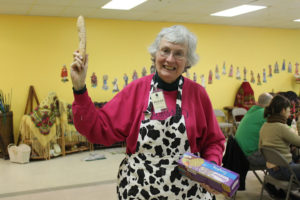
Well it is sunny for once in Oregon and I’m glad it’s not too hot since I know the trees aren’t huge fans of 90 degree heat for multiple days. Although, that’s not the case for humans but you can’t have it all. Enough of the weather, I want to talk to you all about an exciting volunteer role that we are recruiting for here at Friends of Trees. We are looking for folks to jump into the role of Neighborhood Coordinator! But what does a Neighborhood Coordinator entail? Great question!
Here is a brief explanation of what the volunteer role might look for you: Together, NCs and Friends of Trees staff guide neighborhood plantings from beginning to end. No need to be an expert! Interested volunteers will be trained and supported throughout the planting that you will be coordinating. Together with staff, you will:
- Help coordinate one neighborhood planting per year (November-April);
- Respond to homeowner inquiries by email & phone;
- Make phone calls to homeowners that have not ordered their tree(s) to help them make their decision;
- Solicit pick-up trucks or open trailer pullers from neighbors;
- Recruit additional volunteers (Takes quite a few volunteers for one planting);
- Solicit food/monetary donations from the community for breakfast/lunch;
- Set up/coordinate breakfast & lunch for the volunteers on planting day
This is just a brief snapshot of what the volunteer role could be for you! We need NCs in these neighborhoods below:
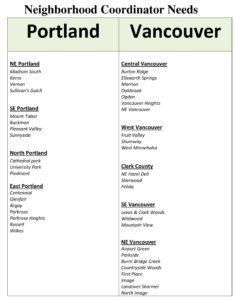
Here are a few pictures that illustrate the results of what NCs accomplish:
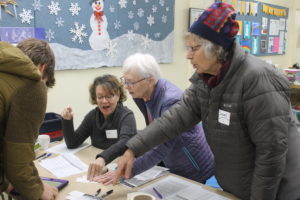
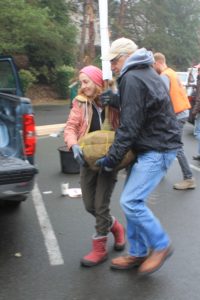
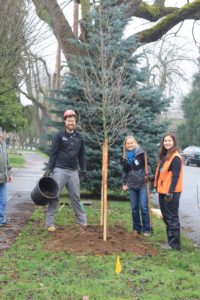

If you know of anyone interested in the role (or yourself) and happen to be in a neighborhood listed in the table above please send them our way, share this blog with them, and cross your fingers that they sign up for the role with our handy registration form. REMEMBER, the best way to share volunteer opportunities is still through word of mouth (or text since that’s how folks seem to communicate nowadays).
Hope you continue to have a great Summer and kudos to you for making it through this detailed blog post!!
Pablo Brito is the Volunteer & Outreach Specialist for Friends of Trees

